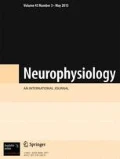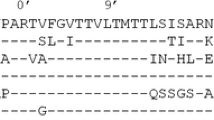The three-dimensional (3D) pattern of a full-size GABAB receptor has been reconstructed using computer techniques. To simulate a real microenvironment for the GABAB receptor, the latter was embedded in the lipid bilayer membrane with the corresponding salt-water environment. Since homology modeling of the GABAB receptor is among the computational methods allowing one to predict 3D coordinates when experimental data are not available, we reconstructed the structure of a full-size GABAB receptor by stepwise homology modeling of individual subunit parts. The stability of receptor subunits was evaluated by calculating the molecular dynamics. It has been found that C-terminal domains of the intracellular receptor show a tendency toward compaction, and coiled-coil areas form a structure almost identical to that specified by crystallization of these fragments. The structure obtained can be applied for further examination of the structural mechanisms of GABAB receptor interaction with GABA agonists and antagonists. It is quite evident that molecular dynamics computations might be a valuable tool in probing details of the receptor function.
Similar content being viewed by others
References
E. Roberts, “GABA: The road to neurotransmitter status,” in: Benzodiazepine/GABA Receptors and Chloride Channels: Structural and Functional Properties, R. W. Olsen and C. J. Venter (eds.), Alan R. Liss, New York (1986), pp. 1-39.
J. Bormann, “Electrophysiology of GABAA and GABAB receptor subtypes,” Trends Neurosci., 11, No. 3, 112-116 (1988).
R. L. Macdonald and R. E. Twyman, “Biophysical properties and regulation of GABAA receptor channels,” Semin. Neurosci., 3, 219-230 (1991).
N. G. Bowery, “GABAB receptor pharmacology,” Annu. Rev. Pharmacol. Toxicol., 33, 109-147 (1993).
A. Couve, S. Moss, and M. Pangalos, “GABAB receptors: A new paradigm in G protein signaling,” J. Mol. Cell Neurosci., 16, No. 4, 296-312 (2000).
E. Cherubini and F. Conti, “Generating diversity at GABAergic synapses,” Trends Neurosci., 24, No. 3, 155-162 (2001).
W. M. Connelly, S. J. Fyson, A. C. Errington, et al., “GABAB receptors regulate extrasynaptic GABAA receptors,” J. Neurosci., 33, No. 9, 3780-3785 (2013).
K. Kaupmann, K. Huggel, J. Heid, et al., “Expression cloning of GABAB receptors uncovers similarity to metabotropic glutamate receptors,” Nature, 386, 239-246 (1997).
A. Bouron, “Modulation of spontaneous quantal release of neurotransmitters in the hippocampus,” Prog. Neurobiol., 63, No. 6, 613-635 (2001).
J. P. Pin, J. Kniazeff, V. Binet, et al., “Activation mechanism of the heterodimeric GABA(B) receptor,” Biochem. Pharmacol., 68, No. 8, 1565-1572 (2004).
Y. Geng, D. Xiong, L. Mosyak, et al., “Structure and functional interaction of the extracellular domain of human GABA(B) receptor GBR2,” Nat. Neurosci., 15, 970-978 (2012).
Y. Geng, M. Bush, L. Mosyak, et al., “Structural mechanism of ligand activation in human GABAB receptor,” Nature, 504, 254-259 (2013).
K. Kaupmann, B. Malitschek, V. Schuler, et al., “GABAB receptor subtypes assemble into functional heteromeric complexes,” Nature, 396, 683-687 (1998).
K. A. Jones, B. Borowsky, J. A. Tamm, et al., “GABAB receptors function as a heteromeric assembly of the subunits GABAB1 and GABAB2,” Nature, 396, 674-679 (1998).
J. H. White, A. Wise, M. J. Main, et al., “Heterodimerization is required for the formation of a functional GABAB receptor,” Nature, 396, 679-682 (1998).
R. Kuner, G. Kohr, S. Grunewald, et al., “Role of heteromer formation in GABAB receptor function,” Science, 283, 74-77 (1999).
S. C. Martin, S. J. Russek, and D. H. Farb, “Molecular identification of the human GABAB R2: cell surface expression and coupling to adenylyl cyclase in the absence of GABAB R1,” Mol. Cell Neurosci., 13, No. 3, 180-191 (1999).
B. A. Clark and S. G. Cull-Candy, “Activitydependent recruitment of extrasynaptic NMDA receptor activation at an AMPA receptor-only synapse,” J. Neurosci., 22, No. 11, 4428-4436 (2002).
R. Cossart, M. Esclapez, J. C. Hirsch, et al., “GluR5 kainate receptor activation in interneurons increases tonic inhibition of pyramidal cells,” Nat. Neurosci., 1, No. 6, 470-478 (1998).
R. Cossart, J. Epsztein, R. Tyzio, et al., “Quantal release of glutamate generates pure kainate and mixed AMPA/kainate EPSCs in hippocampal neurons,” Neuron, 35, No. 1, 147-159 (2002).
S. C. Martin, S. J. Russek, and D. H. Farb, “Human GABAB R genomic structure: evidence for splice variants in GABAB R1 but not GABAB R2,” Gene, 278, 63-79 (2001).
C. H. Davies, S. J. Starkey, M. F. Pozza, and G. L. Collingridge, “GABAB autoreceptors regulate the induction of LTP,” Nature, 349, 609-611 (1991).
D. D. Mott and D. V. Lewis, “The pharmacology and function of central GABAB receptors,” J. Int. Rev. Neurobiol., 36, 97-223 (1994).
Y. Xiang, Y. Li, Z. Zhang, et al., “Nerve growth cone guidance mediated by G protein-coupled receptors,” Nat. Neurosci., 5, 843-848 (2002).
K. M. McClellan, A. R. Calver, and S. A. Tobet, “GABAB receptors role in cell migration and positioning within the ventromedial nucleus of the hypothalamus,” Neuroscience, 151, No. 4, 1119-1131 (2008).
N. G. Bowery, B. Bettler, W. Froestl, et al., “GABAB receptors: structure and function,” Pharmacol. Rev., 54, No. 2, 247-254 (2002).
A. R. Calver, C. H. Davies, and M. Pangalos, “GABAB receptors: from monogamy to promiscuity,” Neurosignals, 11, No. 6, 299-314 (2002).
B. Bettler, K. Kaupmann, J. Mosbacher, and M. Gassmann, “Molecular structure and physiological functions of GABA(B) receptors,” Physiol. Rev., 84, No. 3, 835-867 (2004).
V. Schuler, C. Luscher, C. Blanchet, et al., “Epilepsy, hyperalgesia, impaired memory, and loss of pre- and postsynaptic GABAB responses in mice lacking GABAB R1,” Neuron, 31, No. 1, 47-58 (2001).
C. Zhou, C. Li, H. M. Yu, et al., “Neuroprotection of gamma-aminobutyric acid receptor agonists via enhancing neuronal nitric oxide synthase (Ser847) phosphorylation through increased neuronal nitric oxide synthase and PSD95 interaction and inhibited protein phosphatase activity in cerebral ischemia,” J. Neurosci. Res., 86, No. 13, 2973-2983 (2008).
S. Burmakina, Y. Geng, Y. Chen, and Q. R. Fan, “Heterodimeric coiled-coil interactions of human GABAB receptor,” Proc. Natl. Acad. Sci. USA, 111, No. 19, 6958-6963 (2014).
“The UniProt Consortium. The universal protein resource (UniProt),” Nucl. Acids Res., 36, 190-195 (2008).
J. Marvin, D. Padilla, V. Ravichandran, et al., “The protein data bank,” Biol. Crystallogr., 58, 899-907 (2002).
H. Venselaar, E. Krieger, and G. Vriend, “Homology modeling,” in: Structural Bioinformatics, P. E. Bourne and H. Weissig (eds.), John Wiley & Sons, Hoboken NJ (2009), pp. 715-732.
J.-M. Claverie and C. Noterdame, Bioinformatics for Вummies, Wiley Publ., New York (2007).
I. W. Davis, L. W. Murray, J. S. Richardson, and D. C. Richardson, “MOLPROBITY: Structure validation and all-atom contact analysis for nucleic acids and their complexes,” Nucleic Acids Res., 32, 615-619 (2004).
J. W. Ponder and D. Case, “Force fields for protein simulations,” Adv. Prot. Chem., 66, 27-85 (2003).
H.-D. Holtje, W. Sippl, D. Rognan, and G. Folkers, Molecular Modeling: Basic Principles and Applications, John Wiley & Sons (Wiley-VCH), Hoboken NJ (2008).
K. I. Ramachandran, G. Deepa, and K. Namboori, Computational Chemistry and Molecular Modeling: Principles and Applications, Springer-Verlag, Heidelberg, Berlin (2008).
N. Guex and M. Peitsch, “SWISS-model and the Swiss-PdbViewer: An environment for comparative protein modeling,” Electrophoresis, 18, No. 15, 2714-2723 (1997).
D. Schneidman-Duhovny, Y. Inbar, R. Nussinov, and H. J. Wolfson, “PatchDock and SymmDock: Servers for rigid and symmetric docking,” Nucleid Acid Res., 33, 363-367 (2005).
S. Pronk, S. Pall, R. Schulz, et al., “GROMACS 45: a high throughput and highly parallel open source molecular simulation toolkit,” Bioinformatics, 29, 845-854 (2013).
A. D. MacKerell Jr., N. Banavali, and N. Foloppe, “Development and current status of the CHARMM force field for nucleic acids,” Biopolymers, 56, 257-265 (2000).
A. D. Mackerell, Jr., M. Feig, and C. L. 3rd Brooks, “Extending the treatment of backbone energetics in protein force fields: limitations of gas-phase quantum mechanics in reproducing protein conformational distributions in molecular dynamics simulations,” J. Comput. Chem., 25, 1400-1415 (2004).
W. Humphrey, A. Dalke, and K. Schulten, “VMD –visual molecular dynamics,” J. Mol. Graph., 14, No. 1, 33-38 (1996).
Author information
Authors and Affiliations
Corresponding authors
Rights and permissions
About this article
Cite this article
Nyporko, A.Y., Naumenko, A.M., Golius, A. et al. 3D Reconstruction of a Full-Size GABAB Receptor. Neurophysiology 47, 364–375 (2015). https://doi.org/10.1007/s11062-016-9544-3
Received:
Published:
Issue Date:
DOI: https://doi.org/10.1007/s11062-016-9544-3



